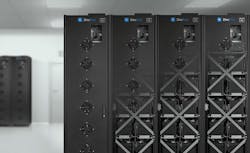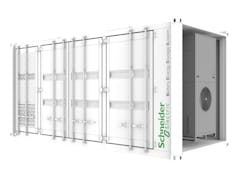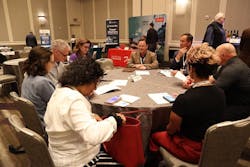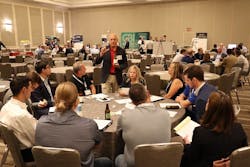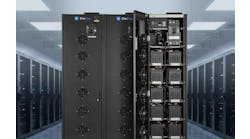As well-noted by a recent blog on the topic by STACK Infrastructure, as the data center industry marches toward widespread decarbonization, the future of backup energy storage represents a fairly mixed bag of challenges and opportunities for data center operators. The following article pulls together recent, notable industry updates and developments in this arena.
With Federal Funding, Iron Mountain Ramps Energy Storage In Virginia
As part of a $2.2 billion grant awarded by the US Department of Energy (DOE) as derived from a $10.5 billion sub-fund known as the Grid Resilience and Innovation Partnerships Program, the State of Virginia was the recent recipient an $85.3 million federal grant, along with South Carolina and private sector partners, for renewable power projects. This includes the installation of new battery technology at Iron Mountain's 140-acre Prince William County data center campus.
As reported by the Richmond Times-Dispatch, Iron Mountain Data Centers has confirmed that it will install a large-scale energy storage system at its data center campus in Manassas. Iron Mountain said the project to install and host a battery energy storage system at the campus has been accepted and conditionally approved, thanks to its collaborative efforts with the VA U.S. Department of Energy (DOE), Grid Forward and ICF.
Energy storage can support broader adoption of renewable energy, allowing large users like data centers to overcome the intermittent generation patterns of wind and solar energy.
"By strategically locating batteries at these facilities, we can leverage their substantial power consumption to provide valuable assistance to the grid," Iron Mountain affirmed on its LinkedIn page. "This support can range from maintaining electrical frequency stability to shifting loads in order to alleviate power constraints while ensuring uninterrupted service for the data center."
Industry Study Probes State of Data Center Battery Backup, Energy Storage
ZincFive and Data Center Frontier recently collaborated to produce a new industry report examining the state of the data center energy storage frontier.
The study acknowledges how, with the data center industry evolving so rapidly and with unprecedented speed and innovation, battery storage technology is emerging as a key area of focus. To help industry professionals navigate the technology's uptake, the new report provides information on usage trends, perceptions, priorities, challenges, future predictions, and the impact of AI on data center energy storage technology.
Survey Demographics
The report gathers survey contributions from 117 diverse, global industry professionals offering insights into the current state of the data center energy storage landscape and future trends as predicted by their peers.
Nearly a quarter (23%) of survey respondents identified their organization’s primary role as a customer of data center services, while 22% identified as data center providers.
More than half of respondent organizations identified as an enterprise data center (55%) and colocation center (52%). Two in five respondent organizations (39%) cited more than 1,000 employees across all locations.
Three in ten (30%) said that their data centers use less than 5 megawatts (MW) across all campuses, while more than a third (36%) said their data centers are using more than 100 MW, with 23% using over 500 MW.
Half of all respondent organizations (51%) said they were using less than 500 kW uninterruptible power supply (UPS) size, while one in ten (11%) said they were using more than 2 MW as their typical deployment UPS size.
Shortfalls in Battery Backup, Energy Storage Technology?
When asked what they were not getting out of their current battery backup/energy storage technology, survey respondents in the study listed the following four top priorities, mentioned in order of frequency: long life, reliability, sustainability, and cost reduction.
In terms of runtime, 26% of respondents expect their runtime to decrease, 38% foresee no change, while the remaining respondents believe it could increase. Only a third of survey respondents (34%) said they completely trust their existing battery backup system.
Of those remaining two-thirds, more than half (57%) felt that the failure point of their existing backup system was human error, followed by the transfer switches (36%) and generators (24%).
Energy storage technology limitations (50%), sustainability targets/mandates (44%) and the transition from centralized to distributed UPS or energy storage platform (41%) were cited as driving the changes survey respondents considered for their energy storage technology.
The Battery Technologies Frontier
The report concludes that newer battery chemistries are gaining traction. ZincFive contends the traction is being driven by a combined set of benefits that data center operators value. When evaluating data center energy storage solutions, two out of three survey respondents (64%) said the lifetime cost consideration/total cost of ownership was a priority.
VRLA cell batteries (64%), LFP batteries (63%), LMO batteries (63%) and nickel-zinc batteries (62%) were rated the highest on safety (excellent + very good + good) among battery types. LFP batteries (60%) were rated the highest (excellent + very good + good) based on sustainability followed by VRLA cell batteries (55%).
When it came to cost, VRLA cell batteries (59%) were rated the highest in the survey (excellent + very good + good), followed closely by nickel-zinc batteries (58%).
Sustainability Top of Mind
Four out of five survey respondents (81%) said that sustainability criteria were important in their power system buying decisions, with the majority of data centers (64%) seen assessing supply chain sustainability and tackling Scope 3 emissions.
Energy storage technology limitations (50%) and sustainability targets/mandates (44%) were cited as driving the changes respondents considered for their energy storage technology. Two-thirds (63%) felt their organization’s sustainability programs have resulted in some cost reductions, with one in five (19%) perceiving “significant” cost reductions.
After implementing sustainability programs, 26% of respondents said they expect runtime to decrease, 38% said they foresee no change, and the remaining respondents said they believe it could increase.
Nearly two-thirds of respondents (64%) said that they are assessing the sustainability performance of their supply chain. 59% of respondents guessed they saw “significantly” better product choices or somewhat better product choices after implementing sustainability programs.
Top Priorities Include Safety, TCO
The study reveals that safety is the top priority for data center backup power. Seven in ten respondents (69%) said that the safety of battery chemistry was a priority (top priority + high priority) when selecting an energy storage solution.
Cost is also important, with lifetime cost and initial Capex revealed as closely correlated. Nickel-zinc batteries, along with valve-regulated lead acid (VRLA) and lithium iron phosphate (LFP) batteries, ranked highly for both safety and cost considerations.
Nickel-zinc (NiZn) batteries, along with valve-regulated lead acid (VRLA) and lithium iron phosphate (LFP) batteries, ranked highly in the survey for both safety and cost considerations.
More than a third of respondents (37%) said were using valve-regulated lead acid (VLRA) cell batteries for centralized UPS energy storage, followed by lithium-ion manganese oxide (LMO) batteries (26%).
AI's Impact Undeniable
When assessing AI’s impact on power requirements and energy storage technology, survey respondents discerned the GPUs' influence in several areas. Such areas included: dynamic load management; predictive maintenance; intelligent battery management systems; advancements in battery technology, and power density.
Also cited as major factors impacted by AI in the data center battery backup and energy storage arena were: sustainability; integration with renewable energy; AI-driven cooling solutions; energy-efficient algorithms, and more.
Download the full report here.
Natron Energy Plants Sodium-Ion Battery 'Gigafactory' in North Carolina
Sodium-ion battery technology specialist Natron Energy, Inc. recently announced plans to build what it calls "the first sodium-ion battery gigafactory in the United States."
Whence gigafactory? The facility will be located in Edgecombe County, North Carolina, and is expected to produce 24 gigawatts (GW) of Natron’s sodium-ion batteries annually at full capacity.
Natron contends its sodium-ion batteries offer higher power density, more cycles, a domestic U.S. supply chain, and unique safety characteristics.
The company cites its batteries as the only UL-listed sodium-ion batteries currently on the market being delivered to a wide range of customer end markets in the industrial power space, including data centers, mobility, EV fast charging, microgrids, and telecom, among others.
North Carolina and Natron
The North Carolina Department of Commerce coordinated the state’s recruitment of Natron Energy, which also involved several state, regional, and local organizations. Plans for the huge sodium-ion battery facility were announced on August 15 by North Carolina Governor Roy Cooper at an Edgecombe County event attended by Natron executives, North Carolina Commerce Secretary Machelle Baker Sanders, and a number of local officials.
The nearly 1.2 million sq. ft. plant, located at the 437-acre Kingsboro megasite, will represent a total investment of nearly $1.4 billion from Natron Energy, facilitated in part by a Job Development Investment Grant (JDIG) approved by the state’s Economic Investment Committee on the same day as the announcement. Over the course of the 12-year term of this grant, the project is estimated to grow the state’s economy by $3.4 billion. The JDIG agreement authorizes the potential reimbursement to the company of up to $21,747,000, spread over 12 years.
Natron and the state also anticipate additional support being provided for the project through the first use of the North Carolina Megasite Readiness Program, a new state grant program open to local governments and designed to provide funds to help prepare or upgrade qualifying industrial sites to the competitive level required in today’s economic development marketplace. Grants from the Megasite Readiness Program are awarded to local governments and must be approved by the state’s Economic Investment Committee, the same body that approves JDIG awards. The state expects Edgecombe County will apply for a $30 million grant from the fund.
“North Carolina’s momentum in the clean energy economy reaches epic proportions with today’s news,” said Governor Cooper. “Natron Energy’s choice to build this large and unique battery factory in our state will help the nation reduce greenhouse gas emissions while creating good jobs in Rocky Mount, Nash and Edgecombe counties, and many other places in eastern North Carolina.”
40x Scale Up for UL-listed Sodium-Ion Batteries
The Edgecombe County facility will enable a 40x scale-up of Natron’s current production capacity, accelerating the company’s technology commercialization while supporting over 1,000 high-quality, local clean energy jobs at full operating capacity.
“Today is a momentous day for Natron Energy. This flagship manufacturing facility will dramatically accelerate our efforts to deliver sodium-ion batteries to customers who are hungry for safe, reliable, and environmentally responsible energy storage solutions,” said Colin Wessells, Founder and co-CEO, Natron Energy.
Natron contends its patented Prussian blue electrodes store and transfer sodium-ions faster, and with lower internal resistance, than other commercial batteries on the market today. The company notes its battery chemistry presents zero strain during charging and discharge, featuring 10x faster cycling than traditional lithium-ion batteries, and 50,000+ cycle life.
Further, Natron emphasizes how its supply chain requires zero lithium, cobalt, nickel, or other difficult-to-obtain minerals. Made from commodity materials including aluminum, iron, manganese, and sodium electrolyte, Natron maintains its cells, modules, and battery represent an environmentally and socially responsible alternative to lead-acid and lithium-ion batteries.
North Carolina Plaudits
Natron cited the following firms for their efforts in making for a successful site selection process in North Carolina: Savills, Boundary Stone Partners, Womble Bond Dickinson, DARCAS Inc., O’Neal Inc., and Quest Site Solutions.
Natron's Wessells said: “After evaluating over 70 sites across 9 states, we found that North Carolina, with its leadership in the clean energy revolution, would make the perfect home for this project. We are proud to partner with the state on this ambitious project to deliver high-quality jobs to the community while advancing the electrification of our economy. We look forward to joining the Edgecombe County business community.”
“This facility advances Natron Energy’s position as the leader of the next battery revolution,” added Wendell Brooks, co-CEO, Natron Energy. “Once operational, the Edgecombe County facility will accelerate Natron’s growth trajectory, allowing us to capitalize on the growing demand for efficient, safe, and reliable sodium-ion battery energy storage. We’re proud to be leading the charge in the advancement of a domestic battery supply chain, and we’re grateful for the partnership of local and state officials here in North Carolina.”
Kohler Energy rebrands as Rehlko
In September 2024, Kohler Energy officially rebranded to its new corporate name Rehlko (pronounced REL-co), marking a major milestone in the company’s 100-plus year history. Rehlko will operate as an independent enterprise following Platinum Equity’s acquisition of Kohler Energy in May 2024.
Kohler Power Systems and Kohler Engines will lead the enterprise portfolio brand transition by officially becoming Rehlko branded by the end of 2024. Rehlko will continue on the organization's self-stated mandate to deliver "innovative, resilient energy solutions that provide independence, agility, and security to mission-critical infrastructure, facilities and residences."
Rehlko will continue to provide equipment control, resilience and innovation through a comprehensive range of energy technologies, including power generation, energy storage, and renewable energy platforms, among others. The company's operating business units now include those for: Power Systems; Engines,; Uninterruptible Power; Home Energy; Clarke Energy; Curtis Instruments, and Heila Technologies.
"This rebranding is more than just a clever name change," said Francis Perrin, chief brand and sustainability officer at Rehlko. "The letters that comprise the name Rehlko reflect our 100-plus years of rich heritage under the Kohler brand and represent a bold step forward in our journey to continue building and powering a sustainable energy future."
Rehlko will continue operating as an independent enterprise. Perrin added, "Our new brand repositions our business at the forefront of innovation and energy resilience technology and showcases our proven ability to deliver to our customers with the energy reliability and control that they demand and require. The Rehlko brand is more focused and purpose-driven than ever before."
The company became a stand-alone entity in May 2024 when Platinum Equity completed a transaction with Kohler Company to establish then-Kohler Energy as a stand-alone business. Platinum Equity is the majority owner of Rehlko with Kohler Company remaining an investment partner.
Founded in 1995 by Tom Gores, Platinum Equity is a global investment firm with more than $48 billion of assets under management and a portfolio of approximately 50 operating companies that serve customers around the world. The firm specializes in mergers, acquisitions and operations – a trademarked strategy it calls M&A&O.
Over the past 28 years Platinum Equity has completed more than 450 acquisitions, acquiring and operating companies in a broad range of business markets, including manufacturing, distribution, transportation and logistics, equipment rental, metals services, media and entertainment, technology, telecommunications and other industries.
"We are embracing our future as an independent company with the new Rehlko brand and celebrating our legacy and our commitment for tackling the most complex energy challenges, and the values that guide everything we do and stand for," said Brian Melka, Rehlko's Chief Executive Officer."
Melka officially unveiled the new enterprise Rehlko brand at the Fast Company Innovation Festival on Sept. 17. The company will soon launch its new corporate website, Rehlko.com, and over the coming weeks and months, will support its new enterprise rebranding through a multi-faceted marketing effort. This will include a targeted advertising campaign to introduce Rehlko across top- tier business and trade industry media publications, with the theme "Resilience is Reinvention."
Melka said, "Our company's new name is derived from the six letters of Kohler and reflects the reliability, resolve, reinvention, and resilience that have been – and will remain – the hallmarks of this organization in addressing the ever-evolving distributed energy needs of the marketplace."
Headquartered in Wisconsin, Rehlko will maintain operations in more than 100 locations across the Americas, Asia, Europe, the Middle East and Africa. The company added that it plans to continue its partnership with the Weber Shandwick Collective and FutureBrand, two of the Interpublic Group's (IPG's) global communications and branding agencies, who have been supporting the rebranding's launch and design efforts, respectively.
Understanding Battery Energy Storage Systems (BESS) for Data Centers
In a new Data Center Frontier white paper released last month, Schneider Electric defines what a Battery Energy Storage System (BESS) is, describes trends driving adoption of this technology, and explains its components, functions, use cases, and architecture considerations.
The white paper examines how data center owners nowadays aspire to maintain resiliency, mitigate energy costs, be sustainable, monetize underutilized assets, and reduce reliance on diesel generators. This reality creates valid use cases for the adoption of BESS technologies. The white paper also provides guidance on what conditions most favor adopting Li-ion BESS for data center use.
Graybar, a top North American distributor of electrical, communications, data networking products, and provider of supply chain management and logistics services, is the inaugural channel partner for Schneider Electric's new BESS, which also offered as part of the company's EcoStruxure platform. As renewable energy is a growing part of Graybar's comprehensive portfolio of solutions, Schneider Electric recently paired its all-in-one BESS with its EcoStruxure Microgrid Flex system for handling by the distributor.
"With over two decades of expertise in battery conversion, we are proud to introduce a solution meticulously crafted to serve multiple energy needs," said Jana Gerber, Schneider Electric's President of North America Microgrids. "Our aim is to streamline energy expenditures while amplifying the use of renewable resources, including solar PV. Combining our proven track record of innovation with Graybar's focus on renewable energy solutions will accelerate this mission."
DCF Trends Summit: Battery Backup Structured Roundtables
To cap off Day Two of sessions for last month's inaugural Data Center Frontier Trends Summit (Sept. 4-6) in Reston, Virginia, a series of expert-led interactive Structured Roundtable sessions for attendees was presented.
Topics for the Structured Roundtables sessions included: Data Center Construction; Edge Data Centers; Hybrid IT and AI Compute; Water Resilience Considerations; and Sustainable Data Center Backup Power.
Session leaders for the Sustainable Backup Power roundtables included: Brian Kennedy, Director of Business Development and Marketing for sodium-ion battery specialist Natron Energy; and Frank Delattre, President - Americas for Musashi Energy Solutions, a developer and supplier of Hybrid Super Capacitor (HSC) technology for data center backup power.
Natron's Kennedy took as his premise how, as organizations continue to launch ESG programs -- the better to reduce their environmental footprint, demonstrate responsible corporate citizenship, and ensure compliance with regulatory agencies -- there is a significant focus on carbon emissions.
And while this piece of the puzzle has a strong impact, Kennedy emphasized how there are other solutions that companies can utilize to address ESG challenges that don’t focus solely on carbon emissions. Kennedy pointed out how there can be impactful ESG initiatives that address ethical supply-chain sourcing, end-of-life disposal, alternative battery technologies, and advanced safety measures.
Since many commonly-used materials for data center battery backup systems can have troubling origins, thediscussion from Natron's and Kennedy's perspective looked at ways of shifting focus to ethically-sourced materials to ensure companies are not participating in damaging practices, such as forced-labor and unsafe conditions, thereby contributing to a healthier supply chain.
Kennedy's discussion also asked whether there's a way to utilize alternative battery technologies, especially those that can be disposed of safely, to solidify the commitment to recycling and sustainability when products reach the end of their life cycle. The message from Natron and Kennedy was that, how organizations ask the right questions and dive deeper into the impacts of their operations to illustrates their commitment to ethical business practices, transparency about processes, and dedication to being a responsible corporate citizen.
Musashi's Frank Delattre set the table for his discussion thusly: As the demand for data center operations continues to surge, driven by the rapid expansion of digital services, cloud computing, and data-intensive applications like AI, the reliability and sustainability of backup power systems have become more critical than ever.
The ensuing roundtable discussion explored the vital role that sustainable backup power plays in ensuring uninterrupted data center operations, particularly in the face of increasing environmental concerns and energy challenges. Delattre's talk examined innovative approaches to integrating renewable energy sources, the impact of emerging energy storage technologies, and the importance of designing resilient, eco-friendly power systems that not only safeguard business continuity but also contribute to reducing the carbon footprint of data centers.
The roundtable discussion shed light on the best practices and emerging trends that are shaping the future of sustainable backup power in the data center industry. For one issue, Dellatre noted how there has always been a debate of the use of large UPS equipment in “ECO-mode” in order to improve efficiency of these systems. The roundtable discussion asked how comfortable are data center operators with using UPS in these modes vs. traditional double conversion modes to obtain gains in efficiency vs. perceived risks in resiliently?
The talk from Musashi's Dellatre also examind how the default for energy storage autonomy has been 15 minutes at EOL for many years now. The discussion acknowledged how this default was primarily driven by old standards that looked at not only transitioning to back-up power generators, but also “graceful” shutdown of systems to assure data integrity as the last resort.
However, Delattre's talk acknowledged how, with today’s complicated, interlinked, applications, graceful shutdown is not even an option, so the main purpose of energy storage is to bridge the gap between the utility outage and back-up generator start. Delattre noted how data center power architectures of isolated redundancy and catcher systems along with latest generator controls are enabling generators to be on-line in 10 seconds.
The question therefore becomes, is having anything more than the “bridging time” of energy storage a waste of resources? Delattre noted that new, more sustainable options such as the Musashi HSC are available for energy storage that focus on the “bridging to generator,” but they depend on how open data center operators are to using less energy storage.
Meanwhile, Delattre's talk also grappled with how diesel generators, while having improved tremendously in their fuel efficiency and reduction of emissions, are still a target to environmentalists. Generators using more sustainable fuels like natural gas or biofuels are available, as well as alternative back-up solutions based on fuel cell technologies.
While these technologies are more sustainable, they come at a higher cost. Delattre's roundtable discussion asked generally: What are the “tipping” points for moving away from diesel generators to more sustainable solutions for back-up sources to the utilities?

Matt Vincent
A B2B technology journalist and editor with more than two decades of experience, Matt Vincent is Editor in Chief of Data Center Frontier.

